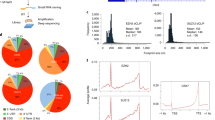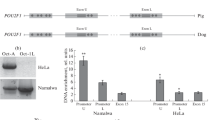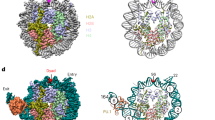Abstract
RNF2, a polycomb group protein, is an important component of PRC complex regulating transcriptional activity. Recently, several RNF2 interacting proteins have been identified. Thus, RNF2 might have multiple activities, depending on its interacting partner proteins. In the present study, using the yeast two-hybrid system, we have found that RNF2 interacts with the PHB2 protein. Luciferase reporter assays showed that RNF2 represses the CP2c-stimulated luciferase activity in a PHB2 dose-dependent manner. Further experiments with RNF2 deletion mutants indicated that RNF21–158 is sufficient for both the physical association and functional co-operation with the PHB2 protein. Co-immunoprecipitation experiments revealed that PHB2 and CP2c bind to the N- and C-terminals of RNF2, respectively. Luciferase reporter assays using α-globin promoter with CP2-binding elements hinted that RNF2 and PHB2 are involved in the CP2-stimulated expression of the α-globin gene. Our study suggests a novel mechanism by which RNF2 and PHB2 modulate the CP2-mediated transcriptional pathway.





Similar content being viewed by others
References
Schoorlemmer J, Marcos-Gutierrez C, Were F, Martinez R, Garcia E, Satijn DP et al (1997) Ring1A is a transcriptional repressor that interacts with the polycomb-M33 protein and is expressed at rhombomere boundaries in the mouse hindbrain. EMBO J 16:5930–5942. doi:10.1093/emboj/16.19.5930
Satijn DP, Otte AP (1999) RING1 interacts with multiple polycomb-group proteins and displays tumorigenic activity. Mol Cell Biol 19:57–68
Garcia E, Marcos-Gutierrez C, del Mar Lorente M, Moreno JC, Vidal M (1999) RYBP, a new repressor protein that interacts with components of the mammalian polycomb complex, and with the transcription factor YY1. EMBO J 18:3404–3418. doi:10.1093/emboj/18.12.3404
Voncken JW, Roelen BA, Roefs M, de Vries S, Verhoeven E, Marino S et al (2003) Rnf2 (Ring1b) deficiency causes gastrulation arrest and cell cycle inhibition. Proc Natl Acad Sci USA 100:2468–2473. doi:10.1073/pnas.0434312100
Lee SJ, Choi JY, Sung YM, Park H, Rhim H, Kang S (2001) E3 ligase activity of RING finger proteins that interact with Hip-2, a human ubiquitin-conjugating enzyme. FEBS Lett 503:61–64. doi:10.1016/S0014-5793(01)02689-8
Wang H, Wang L, Erdjument-Bromage H, Vidal M, Tempst P, Jones RS et al (2004) Role of histone H2A ubiquitination in polycomb silencing. Nature 431:873–878. doi:10.1038/nature02985
de Napoles M, Mermoud JE, Wakao R, Tang YA, Endoh M, Appanah R et al (2004) Polycomb group proteins Ring1A/B link ubiquitylation of histone H2A to heritable gene silencing and X inactivation. Dev Cell 7:663–676. doi:10.1016/j.devcel.2004.10.005
Tuckfield A, Clouston DR, Wilanowski TM, Zhao LL, Cunningham JM, Jane SM (2002) Binding of the RING polycomb proteins to specific target genes in complex with the grainyhead-like family of developmental transcription factors. Mol Cell Biol 22:1936–1946. doi:10.1128/MCB.22.6.1936-1946.2002
Kang HC, Chae JH, Lee YH, Park MA, Shin JH, Kim SH et al (2005) Erythroid cell-specific alpha-globin gene regulation by the CP2 transcription factor family. Mol Cell Biol 25:6005–6020. doi:10.1128/MCB.25.14.6005-6020.2005
Sanchez C, Sanchez I, Demmers JA, Rodriguez P, Strouboulis J, Vidal M (2007) Proteomics analysis of Ring1B/Rnf2 interactors identifies a novel complex with the Fbxl10/Jhdm1B histone demethylase and the Bcl6 interacting corepressor. Mol Cell Proteomics 6:820–834. doi:10.1074/mcp.M600275-MCP200
Lee SJ, Choi D, Rhim H, Kang S (2005) E3 ubiquitin ligase RNF2 interacts with the S6′ proteasomal ATPase subunit and increases the ATP hydrolysis activity of S6′. Biochem J 389:457–463. doi:10.1042/BJ20041982
Choi D, Lee SJ, Hong S, Kim IH, Kang S (2008) Prohibitin interacts with RNF2 and regulates E2F1 function via dual pathways. Oncogene 27:1716–1725. doi:10.1038/sj.onc.1210806
Mishra S, Murphy LC, Murphy LJ (2006) The Prohibitins: emerging roles in diverse functions. J Cell Mol Med 10:353–363. doi:10.1111/j.1582-4934.2006.tb00404.x
Montano MM, Ekena K, Delage-Mourroux R, Chang W, Martini P, Katzenellenbogen BS (1999) An estrogen receptor-selective coregulator that potentiates the effectiveness of antiestrogens and represses the activity of estrogens. Proc Natl Acad Sci USA 96:6947–6952. doi:10.1073/pnas.96.12.6947
Nijtmans LG, Artal SM, Grivell LA, Coates PJ (2002) The mitochondrial PHB complex: roles in mitochondrial respiratory complex assembly, ageing and degenerative disease. Cell Mol Life Sci 59:143–155. doi:10.1007/s00018-002-8411-0
Kurtev V, Margueron R, Kroboth K, Ogris E, Cavailles V, Seiser C (2004) Transcriptional regulation by the repressor of estrogen receptor activity via recruitment of histone deacetylases. J Biol Chem 279:24834–24843. doi:10.1074/jbc.M312300200
Ko YG, Kang YS, Park H, Seol W, Kim J, Kim T et al (2001) Apoptosis signal-regulating kinase 1 controls the proapoptotic function of death-associated protein (Daxx) in the cytoplasm. J Biol Chem 276:39103–39106. doi:10.1074/jbc.M105928200
Delage-Mourroux R, Martini PG, Choi I, Kraichely DM, Hoeksema J, Katzenellenbogen BS (2000) Analysis of estrogen receptor interaction with a repressor of estrogen receptor activity (REA) and the regulation of estrogen receptor transcriptional activity by REA. J Biol Chem 275:35848–35856. doi:10.1074/jbc.M001327200
Pagon Z, Volker J, Cooper GM, Hansen U (2003) Mammalian transcription factor LSF is a target of ERK signaling. J Cell Biochem 89:733–746. doi:10.1002/jcb.10549
Wong CK, Chen Z, So KL, Li D, Li P (2007) Polycomb group protein RING1B is a direct substrate of Caspases-3 and -9. Biochim Biophys Acta 1773:844–852. doi:10.1016/j.bbamcr.2007.02.005
Acknowledgment
This work was supported by the Korea Science and Engineering Foundation (KOSEF) grant funded by the Korean Government (R01-2007-000-20032-0).
Author information
Authors and Affiliations
Corresponding author
Rights and permissions
About this article
Cite this article
Lee, SJ., Choi, D., Rhim, H. et al. PHB2 interacts with RNF2 and represses CP2c-stimulated transcription. Mol Cell Biochem 319, 69–77 (2008). https://doi.org/10.1007/s11010-008-9878-2
Received:
Accepted:
Published:
Issue Date:
DOI: https://doi.org/10.1007/s11010-008-9878-2




